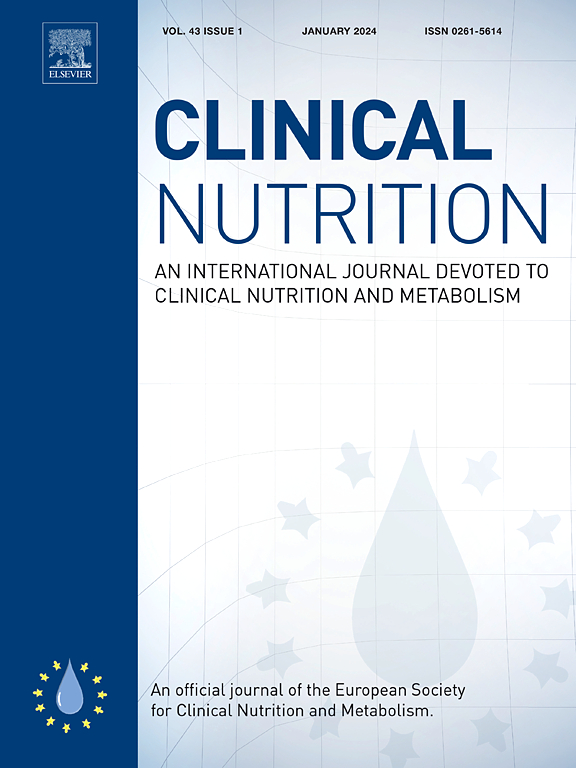骨骼肌密度是腹部创伤患者腹腔感染的新预测指标。
IF 6.6
2区 医学
Q1 NUTRITION & DIETETICS
引用次数: 0
摘要
背景和目的:骨骼肌密度(SMD)是癌症、肝硬化等多种疾病的重要预后指标。然而,SMD 与腹部受伤者腹腔内感染之间的联系仍不清楚。本研究的目的是探讨SMD如何预测腹部创伤患者的腹腔内感染:本研究纳入了 2015 年 1 月至 2023 年 4 月期间腹部受伤的参与者。根据SMD的性别特异性截断值,将全部人群分为两类。通过逻辑回归分析确定了预后因素。ROC用于评估SMD及其与其他生物标志物组合对临床结果的预测准确性:最终共有220名患者被纳入研究。低SMD组患者腹腔内感染发生率较高,住院时间较长,住院费用增加。在腹部创伤患者中,低 SMD 被确定为腹腔内感染的重要独立预测因素(OR 2.397; 95 % CI 1.117-5.141, p = 0.025)。在预测腹腔内感染的 ROC 分析中,与 TRF、NRS2002 评分和 APACHEII 评分相比,低 SMD 具有更高的曲线下面积(AUC)(AUC 0.70,95 % CI 0.61-0.78,p = 0.002)。此外,低 SMD 与住院时间和费用等临床结果也有关联(p 结论:低 SMD 被认为是一种独立的临床指标:低 SMD 被认为是预测此类患者腹腔内感染的独立风险因素。值得注意的是,SMD 正在成为腹部创伤患者腹腔感染的一个新的预测因素。本文章由计算机程序翻译,如有差异,请以英文原文为准。
Skeletal muscle density as a new predictor of abdominal infection in abdominal trauma patients
Background and aims
Skeletal muscle density (SMD) is a valuable prognostic indicator in various conditions such as cancer, liver cirrhosis. Yet, the connection between SMD and intra-abdominal infection in individuals who have suffered abdominal injuries is still unclear. The purpose of this research is to examine how well SMD can predict intra-abdominal infection in patients who have suffered abdominal trauma.
Methods
Participants with abdominal injuries were included in this research from January 2015 to April 2023. Based on the sex-specific cut off values of SMD, the entire population was split into two categories. Prognostic factors were identified through logistic regression analysis. ROC was used to assess the predictive accuracy of SMD and its combinations with other biomarkers for clinical outcomes.
Results
A total of 220 patients were ultimately included in the study. Patients in the group with low SMD exhibited a higher incidence of intra-abdominal infection, longer hospital stays, and increased hospital costs. In patients with abdominal trauma, low SMD was identified as a significant independent predictor of intra-abdominal infection (OR 2.397; 95 % CI 1.117–5.141, p = 0.025). Low SMD had a higher area under the curve (AUC) in ROC analysis compared to TRF, NRS2002 score, and APACHEII score for predicting intra-abdominal infection (AUC 0.70, 95 % CI 0.61–0.78, p = 0.002). Moreover, low SMD showed associations with clinical outcomes such as hospital stay length and costs (p < 0.01).
Conclusions
Low SMD is recognized as an independent risk factor for predicting intra-abdominal infections in this patient population. Notably, SMD is emerging as a novel predictor of abdominal infections in patients with abdominal trauma.
求助全文
通过发布文献求助,成功后即可免费获取论文全文。
去求助
来源期刊

Clinical nutrition
医学-营养学
CiteScore
14.10
自引率
6.30%
发文量
356
审稿时长
28 days
期刊介绍:
Clinical Nutrition, the official journal of ESPEN, The European Society for Clinical Nutrition and Metabolism, is an international journal providing essential scientific information on nutritional and metabolic care and the relationship between nutrition and disease both in the setting of basic science and clinical practice. Published bi-monthly, each issue combines original articles and reviews providing an invaluable reference for any specialist concerned with these fields.
 求助内容:
求助内容: 应助结果提醒方式:
应助结果提醒方式:


